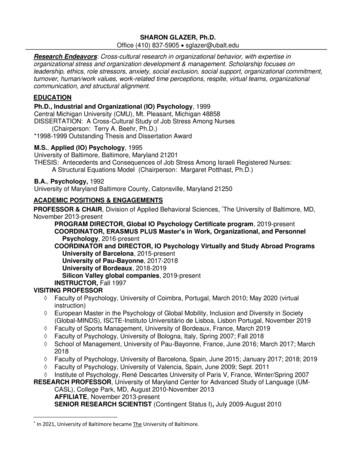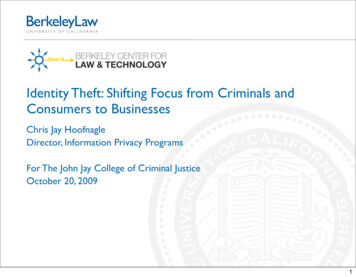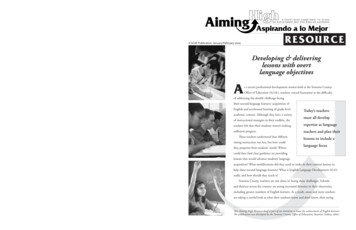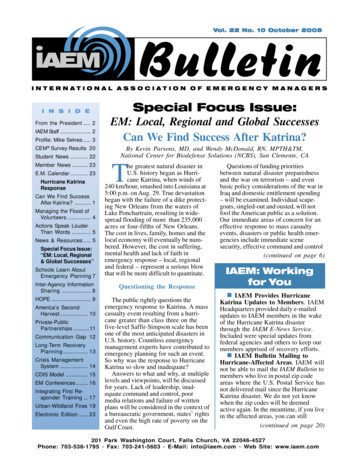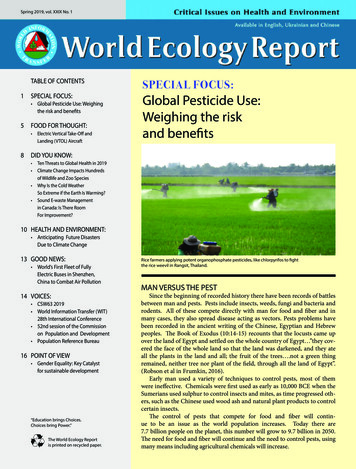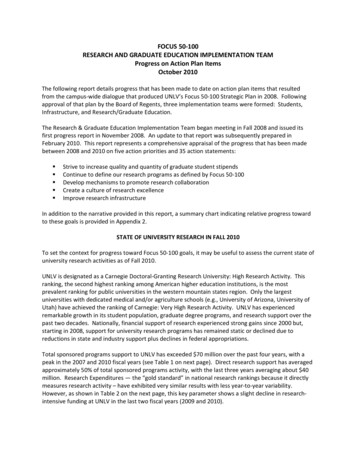
Transcription
FOCUS 50‐100RESEARCH AND GRADUATE EDUCATION IMPLEMENTATION TEAMProgress on Action Plan ItemsOctober 2010The following report details progress that has been made to date on action plan items that resultedfrom the campus‐wide dialogue that produced UNLV’s Focus 50‐100 Strategic Plan in 2008. Followingapproval of that plan by the Board of Regents, three implementation teams were formed: Students,Infrastructure, and Research/Graduate Education.The Research & Graduate Education Implementation Team began meeting in Fall 2008 and issued itsfirst progress report in November 2008. An update to that report was subsequently prepared inFebruary 2010. This report represents a comprehensive appraisal of the progress that has been madebetween 2008 and 2010 on five action priorities and 35 action statements: Strive to increase quality and quantity of graduate student stipendsContinue to define our research programs as defined by Focus 50‐100Develop mechanisms to promote research collaborationCreate a culture of research excellenceImprove research infrastructureIn addition to the narrative provided in this report, a summary chart indicating relative progress towardto these goals is provided in Appendix 2.STATE OF UNIVERSITY RESEARCH IN FALL 2010To set the context for progress toward Focus 50‐100 goals, it may be useful to assess the current state ofuniversity research activities as of Fall 2010.UNLV is designated as a Carnegie Doctoral‐Granting Research University: High Research Activity. Thisranking, the second highest ranking among American higher education institutions, is the mostprevalent ranking for public universities in the western mountain states region. Only the largestuniversities with dedicated medical and/or agriculture schools (e.g., University of Arizona, University ofUtah) have achieved the ranking of Carnegie: Very High Research Activity. UNLV has experiencedremarkable growth in its student population, graduate degree programs, and research support over thepast two decades. Nationally, financial support of research experienced strong gains since 2000 but,starting in 2008, support for university research programs has remained static or declined due toreductions in state and industry support plus declines in federal appropriations.Total sponsored programs support to UNLV has exceeded 70 million over the past four years, with apeak in the 2007 and 2010 fiscal years (see Table 1 on next page). Direct research support has averagedapproximately 50% of total sponsored programs activity, with the last three years averaging about 40million. Research Expenditures — the “gold standard” in national research rankings because it directlymeasures research activity – have exhibited very similar results with less year‐to‐year variability.However, as shown in Table 2 on the next page, this key parameter shows a slight decline in research‐intensive funding at UNLV in the last two fiscal years (2009 and 2010).
TABLE 1UNLV Sponsored Program AwardsAwardsFY 05FY 06FY 07FY 08FY 09FY 10All Sponsored Programs Awards 73.2 67.4 106.7 73.7 76.5 96.0Research Awards Only 48.2 42.1 74.7 39.8 40.0 38.4ExpendituresFY 05FY 06FY 07FY 08FY 09FY 10All Sponsored Programs Activity 79.8 91.7 104.9 99.4 87.4 100.0Research Activity Only 40.4 48.0 54.1 46.8 36.2 35.9TABLE 2UNLV Research Expenditures2
It is within this context of these data (and still deeper data provided in Appendix 1) that the Research &Graduate Implementation Team offers the following progress report. The report is organized using the“Research Priorities” identified through the strategic planning process. It is important to note that manyof these priorities represent large, multi‐year efforts; however, the status of each item is addressedherein. New or revised priorities as recommended by the implementation team are added at the end ofeach section.ACTION PRIORITY 1:Strive to Increase Quality and Quantity of Graduate Student Stipends1. Use access funds to expand recruiting of highly qualified students.With input from GPSA President Jessica Lucero and assistance from Norm Bedford and Craig Organek,the implementation team proposed a series of Graduate Access scholarship programs funded bygraduate access monies, including a childcare scholarship, a scholarship for graduate students with thehighest financial need and the highest GPAs, a scholarship for international students with the highestGPAs, and a scholarship to support GAs who have federally determined (i.e., FAFSA) financial need.These scholarships began in 2008‐2009 and were directed to address both recruitment and retention ofgraduate students.2. Increase graduate student scholarship support.With assistance from GPSA President Jessica Lucero and representatives of the UNLV Foundation, in2008 the Graduate College began to expand outreach efforts to increase graduate scholarship andfellowship support on campus. The Hermsen Fellowship in the School of Life Sciences was the first newfellowship born of this type of collaboration; it was awarded for 2009‐2010. Next steps involvedreaching out to college development officers to propose closer collaboration in the area of graduatescholarship and fellowship fund development during the 2009‐2010 academic year. The GraduateCollege helped prepare high‐quality print materials that fund‐raisers could provide to potential donors.These efforts have already seen some limited success in just two years.The College of Sciences added additional fellowships with funding from the Ross and Wyman scholarshipprograms. The Lincy Institute, established in 2009 by a substantial private gift, is supporting three newgraduate assistantships. The Urban Sustainability Initiative is supporting seven graduate assistantshipsthrough federal grant funding, and Nevada NSF EPSCoR is supporting approximately 10 additional GAs.There is a new Renewable Energy Scholarship for 2010‐2011, as well as the Sterling Award, which isfunded through the Alumni Association. However, the current economic downturn has resulted in theloss of several graduate fellowships/scholarships, including a Presidential Fellowship, a BarrickFellowship, the Rogers Fellowship, and summer session GAs, and there is some uncertainty about thefuture of several others. The goal to increase graduate scholarship support will require vigilance andlong‐term effort.Because state funding for GAs has remained static since at least 2003‐2004, it has been difficult for theuniversity to address the issue of increasing the stipends per graduate assistantship. While a minimumbase stipend of 13,000 per 12‐month master’s GA and 16,000 per doctoral GA is standard across theuniversity, individual departments and colleges may elect to increase the stipend to more competitivelevels. Unfortunately, this decreases the total number of GAs they may award, but it does provide an3
interim solution – particularly in the sciences and engineering – for allowing UNLV to remain somewhatcompetitive with the stipends offered by peer institutions. It should be noted that the current optionfor stipend flexibility does not allow departments to outbid the competition but merely to keep pace.3. Change the state’s formula funding.UNLV pursued changes to formula funding by the state during the 2009 legislative session withassistance from the GPSA, but it was met with limited success largely due to the budget crisis. TheNevada System of Higher Education has pledged to pursue changes to the formula during the 2011legislative session, and this goal will continue to have full faculty and student support.4. Establish graduate student housing as a recruitment mechanism.During academic year 2008‐2009, implementation team members and representatives from StudentLife, Student Housing, and the Midtown UNLV project met to discuss needs and plans for graduatestudent and family housing. Due to the economy and recent budget cuts, there has been no progress oncreating additional graduate student housing, and action on this goal will necessarily be a multi‐yearinitiative. However, the dialogue with developers in the area is continuing, and existing housing optionsfor graduate students are now more readily accessible on the Student Life website and the GraduateCollege website. If an assessment of graduate housing needs is deemed necessary, the GraduateCollege will conduct a study, and it continues to work with the GPSA on this, as it is an issue of someconcern to this group.TEAM‐ADDED PRIORITIES NOT INCLUDED IN THE ORIGINAL 50‐100 ACTION PLAN1. Reorganize and revitalize the Graduate Assistant program.In collaboration with the Provost’s Office, in academic year 2009‐2010 the Division of Research andGraduate Studies developed a plan to reorganize the state funded GA program. This included efforts toassess minimum GA stipend amounts, to better monitor the use of GAs, and to reallocate GA funds tocollege deans in order to create incentives for FTE generation and achievement of critical graduate andresearch goals, including graduating more doctoral students. Following extensive discussion with thecollege deans, the plan was finalized in winter 2009 and implemented in Spring 2010.The new GA funding allocation model is in place for 2010‐2013. Fifty state GA lines have been allocatedon a competitive basis to support collaborative faculty/graduate student research and scholarly activity;this plan supports recommendations identified through UNLV’s 50‐100 Strategic Planning process. Anannual workload assessment is in place to monitor GA assignments and to ensure that at least 80% ofstate‐funded GAs are teaching 6 credits, or the equivalent, per semester. The PTI‐GA lines have beeneliminated, and those funds were rolled into the state GA allocations.Currently, the Graduate College is examining, and hopes to implement within a year, electronicprocesses for GA applications, GA hiring documents, and signatures on GA paperwork in order to makecontract signing and employee orientation more efficient and less cumbersome for students and faculty.4
2. Better use externally funded research awards as a means to support graduate student researchand training.The Graduate College continues to work to promote the inclusion of graduate assistant lines in facultygrants whenever feasible, but this will entail a multi‐year effort. University‐wide, the number of GAscurrently funded by grants is 227 (out of 1,019 total GAs), representing 3.3 million in additionalfunding. Examples of grant‐funded GAs include NSF EPSCoR (10), Urban Sustainability Initiative (7), theLincy Institute (3), and numerous others through the National Science Foundation and Department ofEnergy. Another important component of this effort will be educating faculty about including higherstipends for GAs in their external proposals.A multi‐pronged approach has been employed to assist faculty and graduate students with improvingtheir proposal‐writing skills. The Graduate College Professional Development Committee will initiate aResearch Certificate program in Fall 2010, including a proposal‐writing component, to encouragegraduate student research activity and funding. Proposal‐writing workshops for faculty and graduatestudents are available through the GPSA, and training on the Responsible Conduct of Research is nowoffered each semester, including summer. The Graduate College has also created a new webpage toprovide information and easy step‐by‐step calculation of the cost associated with hiring a GA using grantor contract funds. All of these efforts will continue.3. Examine how state‐funded GA lines are used currently.The implementation team collected and analyzed new data on state‐funded GAs, and the GraduateCollege conducted a workload study in Fall 2009 to assess how state GA lines were being used bygraduate programs. The data generated from this study were used to inform the new GA funding modelthat was implemented in Spring 2010. As the new model completes its first full academic year ofimplementation, the Graduate College plans to assess the success of the program annually.ACTION PRIORITY #2:Continue to Define our Research Programs As Defined by Focus 50 to 1001. Continue discussions with faculty stakeholders to create an inclusive research environment.Initial faculty stakeholder discussions commenced through the 50‐100 planning process. One of thesuggestions emanating from that process was to purchase and implement a Digital Measures softwareapplication. This project will create a comprehensive faculty expertise database that is intended toimprove faculty communication about their research interests and to better assist faculty incollaborating with colleagues across departments and colleges. The project has been delayed at severalpoints due to limited funding and staff resources as well as a change in project leadership. However,professor Jerry Chang was recently appointed faculty lead for the project, vendor selection has beencompleted, and an updated implementation schedule is being developed.The Urban Sustainability Initiative, the Lincy Institute, and Brookings Mountain West are encouragingcollaborative, multi‐disciplinary faculty and student research in a number of areas relevant to theuniversity’s mission. In Fall 2010, the Lincy Institute will award 6 competitive faculty fellowships of up to 20,000 each to support faculty scholarship in education, health care, and social services. VisitingBrookings Scholars from Washington, D.C. are paired with UNLV faculty and students during their on‐5
campus residency, and several collaborative research projects have already resulted from theseinteractions. As noted with more detail later in this report, the Urban Sustainability Initiative issupporting several interdisciplinary teams of faculty researchers as well as GAs in a variety of academicdepartments.The Science and Engineering Building is hosting a seminar series to foster interdisciplinary interactionand research, and the Office of the Vice President for Research will continue to work with the DeansCouncil to promote interdisciplinary research in all of the colleges.2. Publicize research activities more broadly and brand those efforts.This ongoing effort is currently being addressed through a variety of internally produced media,including UNLV Innovation, the “Voices of Research” video, a redesigned research website, UNLVMagazine, and numerous publications produced by the academic colleges. Several colleges (e.g.,Sciences) have active campaigns to publicize their research efforts and activities. A few departmentspublicize faculty research activities in their departmental newsletters (e.g., ECE Newsletter, 2008). TheUNLV Foundation also promotes news of private gifts used to support faculty research in its “InspiringAchievements” online newsletter.Extensive promotional materials were developed to launch the Brookings Mountain West Initiative andThe Lincy Institute in Fall 2009. Media coverage of the Brookings Scholars’ presentations is ongoing. Anew website for the Science and Engineering Building has been launched, and the formal dedication ofthe building in Spring 2011 will provide still more opportunities to publicize faculty research. Plans arealso being developed for “science on display” activities in the facility, which, depending on adequatefunding and staffing, may include viewing research through windows in the labs, video monitors in thelobby featuring program videos and video feeds from laboratories, glass case exhibits, a faculty seminarseries, and the like.Additionally, media coverage of UNLV researchers and their projects in the local and regional press hasbeen more abundant and more positive in recent years. Greater numbers of research‐oriented featurestories representing a variety of disciplines are being pitched successfully to the media. However, cost‐cutting measures are negatively affecting the university’s ability to produce printed publications andother collateral materials. The Division of Research and Graduate Studies continues to encouragefaculty to include provisions for communication materials in their grant proposals. Websites andelectronic publications are increasingly being used to publicize research. Recently, an institutionalelectronic repository/archive was established by the Lied Libraries, and it holds great promise forpromotion of UNLV scholarly activity both nationally and internationally.3. Focus faculty hires in areas directly relevant to UNLV’s strategic goals.Focused faculty hiring has been under way in units such as Chemistry (e.g., materials chemistry andradiochemistry) in the last few years, and it remains a high priority of the Executive Vice President andProvost. However, budget constraints may delay pursuit of this goal, as very few faculty hires areanticipated in the next biennia and possibly beyond. It should be noted that the delay in addressing thisgoal makes it increasingly important for the university to place emphasis on high quality programs inresearch focal areas. Increasingly, the university must work to acquire and use external funding to buildfaculty in key areas. This is already occurring in certain units. For example, as part of the NSF EPSCoRproject, there will be three targeted faculty hires starting in Fall 2011 in Urban Affairs, Science, and6
Engineering related to climate change. Additionally, there have been two hires in the biomedical area(one from Harvard Medical School) through the NIH‐INBRE program, and a third hire is planned for Fall2011. A proposal to the Department of Energy to create a Solar Solutions Center includes funding fornumerous high quality faculty hires.All of these targeted efforts must emphasize hiring faculty who bring with them substantial competitivefunding in order to build the university’s overall research program.A new visiting and adjunct faculty program has been established with NSTec, the primary contractor forresearch and operations at the Nevada National Security Site (formerly the Nevada Test Site). This effortwill bring NSTec nuclear physicists and radiochemists into UNLV’s colleges of Science and Engineering.A similar program, with an expectation for multiple joint faculty appointments, is being created with theNevada Cancer Institute.Statewide, research officers within the Nevada System of Higher Education are defining common highneeds areas to boost Nevada’s overall economic diversification. The 2009 Nevada Science andTechnology Plan identifies nine key areas where NSHE institutions already have research strengths thatbenefit state needs and/or goals. The Nevada Vision Stakeholder Group recently issued its report withstrategies and goals for advancing quality of life in the state. NSHE officers and other constituent groupswill be lobbying the 2011 Legislature to implement a plan to emulate the Utah USTARS initiative, whichis intended as a comprehensive state initiative to fund research and technology development, as well asworkforce development, at NSHE institutions.4. Increase the quality of existing graduate programs.Assessment of quality of graduate programs is a continuing process. Program review protocols havebeen recently updated and improved. Resources are being dedicated to support graduate studentprofessional development and their research endeavors through programs in the Graduate College andGraduate and Professional Student Association (GPSA). Ongoing efforts to improve the recruiting andretention of top‐quality students through financial assistance were addressed earlier in this report.The Graduate College and the Graduate Council continually seek to improve internal processes to enablegraduate coordinators and students to focus on the quality of the academic experience rather thanadministrative/business practices. A variety of electronic initiatives have been launched in the last twoyears that have streamlined processes immensely, including electronic storage of records, creation of aportal for
graduate programs. The data generated from this study were used to inform the new GA funding model that was implemented in Spring 2010. As the new model completes its first full academic year of implementation, the Graduate Col


